#npa
Text

#Anuradha Ghandy#women's liberation#the philippines#flip#cpp#npa#revolution#revolutionary#marxism leninism maoism#marxism#maoism#communism#communist#maoist#socialism#MLM
503 notes
·
View notes
Text
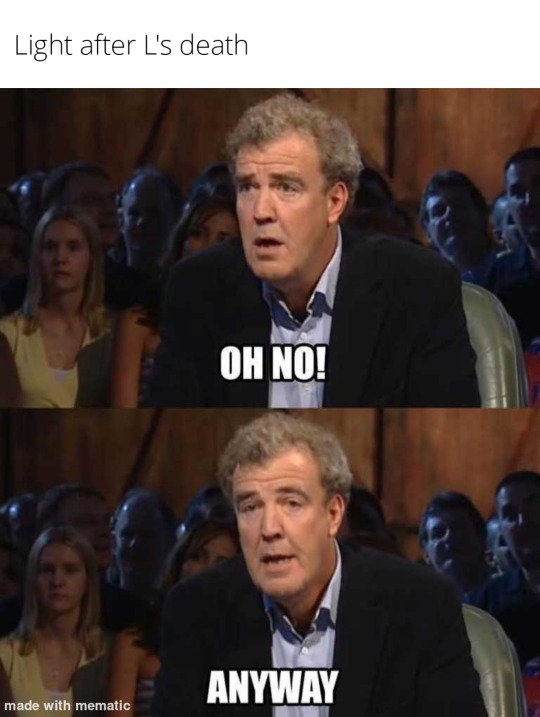
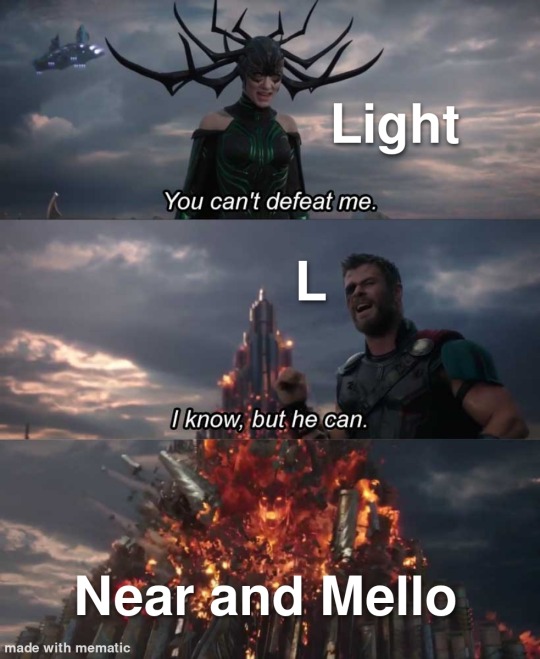
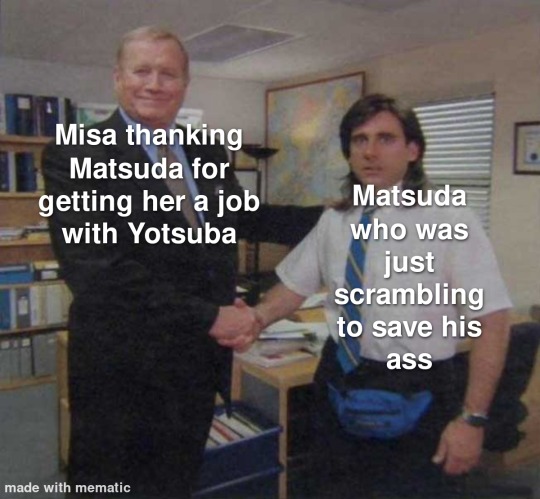


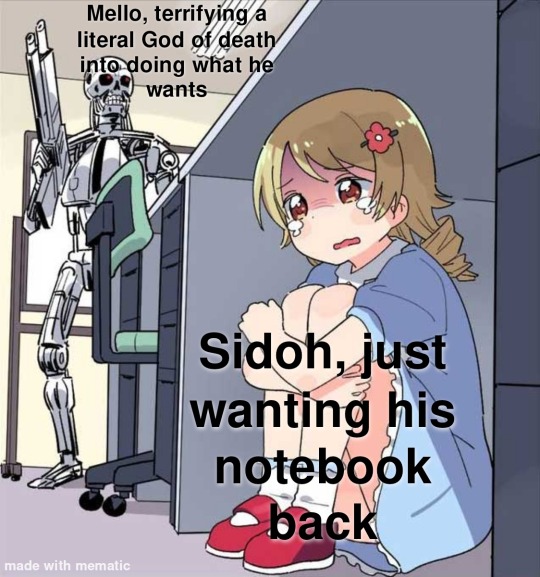
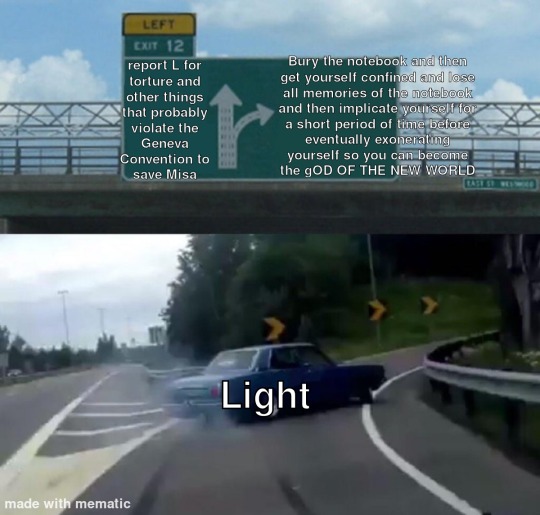
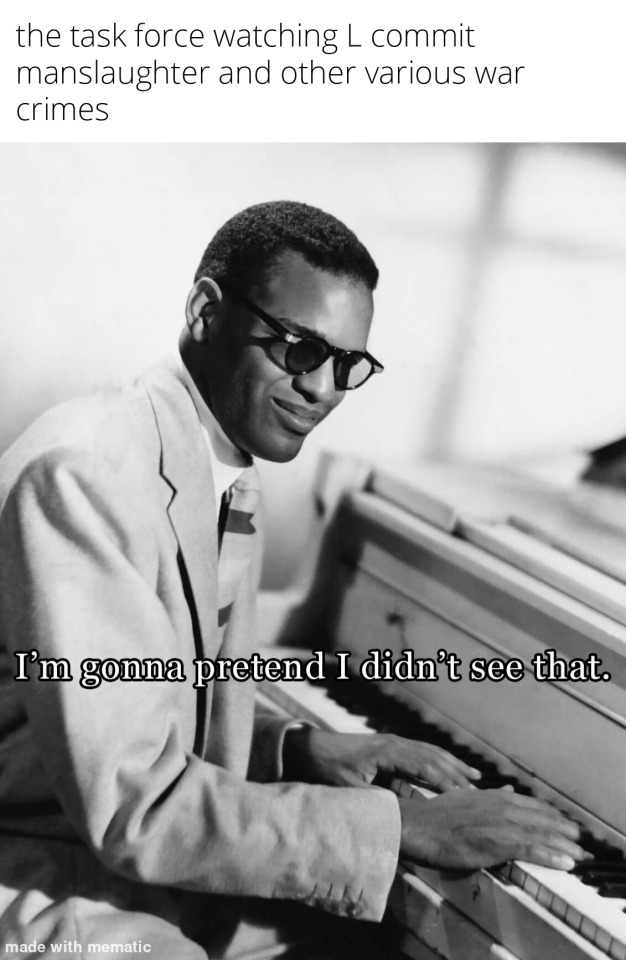
#death note#death note memes#sidoh#shinigami#mello#near#l lawliet#light yagami#japanese task force#npa
71 notes
·
View notes
Link
The greatest Filipino of the past century bereaved us peacefully last night.
Prof. Jose Ma. Sison, founding chair of the Communist Party of the Philippines, passed away at around 8:40 p.m. (Philippine time) after two weeks confinement in a hospital in Utrech, The Netherlands. He was 83.
The Filipino proletariat and toiling people grieve the death of their teacher and guiding light.
The entire Communist Party of the Philippines gives the highest possible tribute to its founding chairman, great Marxist-Leninist-Maoist thinker, patriot, internationalist and revolutionary leader.
Even as we mourn, we vow continue to give all our strength and determination to carry the revolution forward guided by the memory and teachings of the people’s beloved Ka Joma.
Let the immortal revolutionary spirit of Ka Joma live on!
December 17, 2022
#KaJomaLives#Jose Maria Sison#Philippines#communist#revolutionary#Maoist#memorial#CPP#NPA#NDFP#Struggle La Lucha
49 notes
·
View notes
Text

Studio head-and-shoulders portrait of unidentified young woman, wearing formal Victorian evening dress, hair gathered in ringlets with small flowers, hoop earrings and necklace. Printed on front: "Bigelow, NPA, Detroit." Printed on back: "Bigelow, photographer, No. 244 Woodward Avenue, Detroit, Mich."
Burton Historical Collection, Detroit Public Library
#portrait#portrait photography#bigelow#lyman g. bigelow#detroit#detroit history#vintage#hair#ringlets#victorian dress#carte de visite#npa#detroit public library
68 notes
·
View notes
Note
Hello, yes, I and some of the other monarchs are starting an organization called NPA. NPA stands for, "Naja Protection Agency." We have decided amongst ourselves that Naja must be protected at all costs in every playthrough in every universe. We will be taking in Naja's who have been mistreated or cast aside by their Monarchs and giving them a place with us. We have plenty of love to give and lets be honest, Naja deserves it.
Thank you,
Monarch Eilonwy, NPA president
I hereby give you, Monarch Elionwy, and your organisation the official permission to rescue and care for Najas who are in need of it
53 notes
·
View notes
Text
youtube
Singing in the millennium with you.
#killing joke#millenium#npa#npa canal+#1994#jaz coleman#geordie walker#youth glover#kevin walker#martin glover#geoff dugmore#nick holywell-walker#alternative#alternative rock#post punk#gothic#gothic rock#dark wave#industrial#metal#industrial metal#industrial rock#uk#england#france#french#french tv#cheltenham#Youtube
2 notes
·
View notes
Note
What's your opinion on Kuroda Hyoue being the disguised Tsutomu Akai?
I think it would make his character even more interesting, but if he isn't I don't know where and who Tsutomu could be.
And if he is did he meet his kids? I think he met Sera but I am not sure.
"Kuroda Hyoue = Akai Tsutomu" Theory (Updated)
This is my current speculation on Kuroda Hyoue's identity, I will keep it updated as we get new developments.

I think that Kuroda Hyoue is indeed Akai Tsutomu's current identity. Kuroda shares many similarities with Akai Tsutomu and especially his son (Akai Shuuichi). They both have similar fashion sense, with a contrasting white-coloured tie to a dark shirt and a brown overlay, and when it comes to Shuuichi, we got visual cues where they not only stood the same way with hands in their pocket, but also demonstrated the same leg sweep technique (File 989 & 1016), which is most likely intended to indicate that they share the same martial arts (Jeet Kune Do) that Akai Tsutomu was revealed to have mastered (File 1099 & SDB 90+).

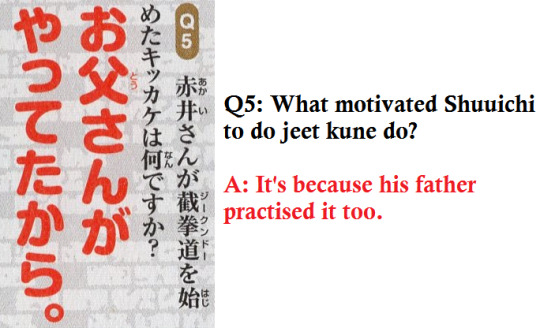
Kuroda was also especially interested in the Kohji case, to the point of seemingly noticing a dying message-like name in the news (File 980 & 987). This fits with Akai Tsutomu's interest, that started after Haneda Kohji's father (Haneda Yasuharu), who is Tsutomu's friend, requested that he solved his son's murder (File 1037).
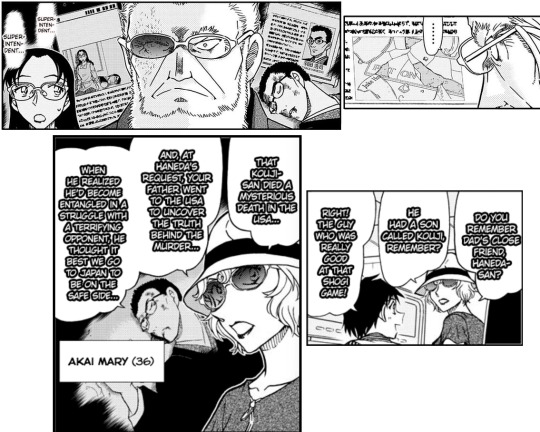
Here is how I currently suspect he turned from a seemingly deceased MI6 agent from Britain to a member of the NPA's Public Security in Japan in the last 17 years.
We know from File 1048-1049 that Tsutomu had a confrontation with Vermouth 17 years ago after his investigation on the Kohji case, and that clash lead to him being presumed dead by the BO. We then learned in File 1099 that Wakasa and a "monster" (Rum) was involved in what potentially was that same incident that lead to his presumed death 17 years ago.

As I speculated before, I think that Tsutomu's investigation lead him to finding out that Kohji's dying message revealed "Karasuma" to be the culprit, and that the prime suspect Asaka is innocent. I think that Rum found out about Tsutomu's investigation and baited him to a location using Vermouth, who disguised as "the innocent bodyguard Asaka" and carried Kohji's shogi piece charm as proof to convince him. Before going to the meeting location, Tsutomu warned his family about making enemies with bad people and told them to move to Japan, so that his family's whereabouts aren't discovered (File 972), in case he doesn't survive the planned meeting with "Asaka" (similar to Mary's contingency plan of having Masumi contact MI6 about fake Tsutomu in case Mary didn't make it back in File 1049).

That lead to Tsutomu finger jabbing Rum's left eye (as hinted by Gosho in the OdaxAoyama interview and File 972) and ultimately getting defeated by Rum after letting his guard down around Vermouth (Fake Asaka/Wakasa).


I suspect that Tsutomu's confrontation with them lead to him surviving (like Mary) and changing his identity and appearance (likely through plastic surgery). Afterwards, to pursue the organization further, it makes sense that he would have moved to Japan, where the culprit(s) "Karasuma" originate from, just like the other overseas agents (i.e Hondou Ethan from the CIA). Just like Mary, who got ahold of a fake pass to fly to Japan (revealed by Gosho in SDB 100+), Tsutomu had also gotten ahold of a fake pass with the alias "Kuroda Hyoue".

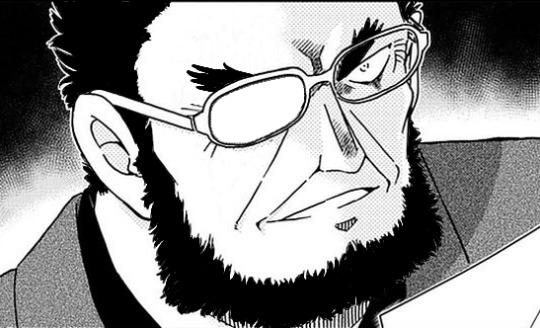
I think that he then decided to investigate the Karasuma Group/Black Organization, by becoming a public security officer of the Japanese police (in order to extract information easier, as referenced in File 1033).

In order to get a pass into the police academy in Japan (disregarding of his blank background), I suspect that Kuroda/Tsutomu secretly relied on his relationship with the head of the Ōoka Group (who is currently retired) that was revealed in File 1088, similar to how his friend Haneda Yasuharu did in File 1039-1042.

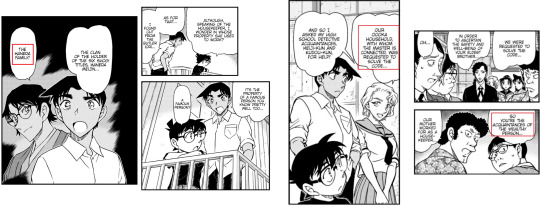
The Ōoka family has been shown and hinted to have great influence and connections with people in high positions, like the Tokyo governor (File 992), making them more than capable of helping Kuroda/Tsutomu join the japanese police.

In other words, the same time as his eldest son started to work towards becoming an FBI agent 17 years ago (File 972), Kuroda started to work towards getting accepted by the National Police Agency (File 913). He then built himself up and became what I think is the backstage administrator of the NPA's security planning division (who recieves all the classified reports of their NOC:s), all within 7 years.

Seven years later (since his disappearance), Kuroda/Tsutomu has made a name for himself within the NPA and has diligently kept his safe distance from his family, but before the status quo with his family could change, an incident took place around 10 years ago, that lead to his 10-year-long coma (File 914). We recently learned that Iori Muga, the current butler of the Ōoka family, was a former coworker of Kuroda within the Public Security, who went with the alias "Sakakibara" while undercover, which was likely before Kuroda's 10-year coma (File 1090).
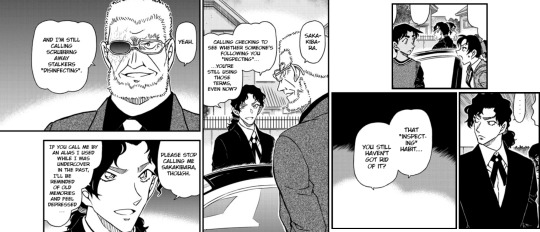

I think that what lead to Kuroda's burn-scar-causing and right-eye-losing incident 10 years ago was that Iori Muga (who is actually Rum's true appearance) deemed Kuroda as a threatening and formidable enemy to the black organization. He therefore secretly orchestrated the incident that made Kuroda fall into a coma. Kuroda's hair colour changed due to the stress of the incident (his hair was perhaps shaved off for surgery purposes and white hair grew instead) and he didn't wake up until 10 years later (File 914).

I suspect that when Kuroda/Tsutomu woke up from his coma, he suffered actual memory loss to an extent, which is why he was perceived to have become a different person (As Yui mentioned). This concept was already foreshadowed as a possibility through Vermouth's disguise cover story when she faced Mary as Tsutomu (File 1048).

This would also explain why Kuroda immediately reacted to Wakasa Rumi in the news in File 980, while also still acting unaware of her identity as if he is trying to confirm suspicions of her being a criminal tied to the Kohji case in File 987-989, despite potentially having met her 17 years ago as Tsutomu. The amnesia could have made him forget her potential role in his demise 17 years ago, but he still found her familiar enough to the point of investigating her and making the connection between her name and Kohji's dying message.


While he may have forgotten significant things from his life as Tsutomu, his goal to take down the BO and find out who Kohji's killer is hasn't changed. Although the NPA had him move to Nagano to ease back into his work (before he moved to Tokyo MPD as the new superintendent), I think they gave Kuroda permission to still keep his Backstage administrator role active and stay in contact with their NOC ("Bourbon"/Furuya Rei) by Kuroda's request (File 1017).
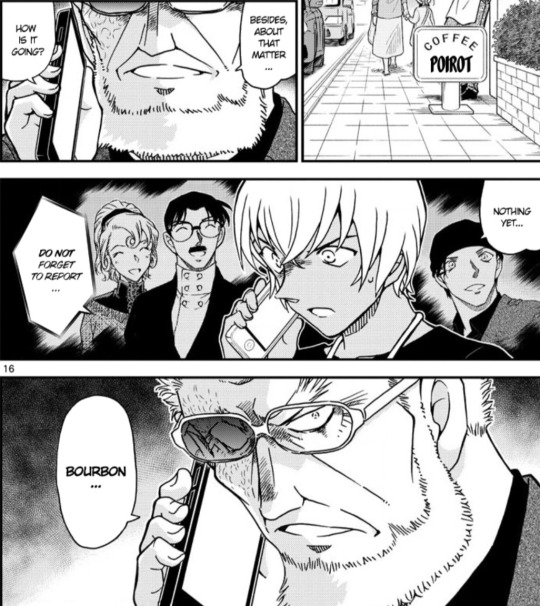
#Detective Conan#Rum Arc#Kuroda Hyoue#Akai Tsutomu#National Police Agency#NPA#Public Security#Security planning division#backstage administrator#MI6#Secret Intelligence Service#SIS#Ōoka#Ooka#Ooka Group#Karasuma#Karasuma Group#Iori Muga#Rum#Wakasa Rumi#Vermouth#Akai Mary#Akai Shuuichi#Sera Masumi#Furuya Rei#Bourbon#Sakakibara#Haneda Kohji#Haneda Yasuharu#Haneda Kohji case
21 notes
·
View notes
Text
A transwoman in the people’s army

For more than a year now, Ka Daisy, a transwoman, has served as full-time Red fighter. She joined the New People’s Army (NPA) during the pandemic, three years after doing revolutionary work as a member of the Kabataang Makabayan. She recounted how her unit got engaged in an armed encounter on her second day in the unit.
Ka Daisy, also called “Inday” by some comrades, now serves as a squad political guide. As an official, she ensures the strengthening of the organization. She helps outline plans and programs, and ensures its implementation. She also performs daily technical tasks such as fetching water, cooking, and transporting supply.
“I have total respect for Ka Daisy,” said Ka Alas, her squad leader. “Apart from being helpful, she teaches well. Since her deployment here, she took to teaching me LitNum (literacy/numeracy). Because I’m quite past my prime, I sometimes forget our lessons, but Inday keeps encouraging me to learn.”
Ka Daisy was warmly received by comrades as a new recruit. On her part, she was able to quickly adapt to the NPA’s military regulations.
“Even before I joined the unit, comrades were oriented about my gender. They had study meetings about the LGBT struggle,” said Ka Daisy. In her unit, instructors include the LGBT orientation when giving basic military orientation. This aims to correct wrong views and treatment of LGBTs. Some misconceptions still manifest, but these are collectively struggled in a structured and comradely manner.
Like other comrades, Ka Daisy carries a heavy pack. Her bag contains printed reading materials such as Ang Bayan and other documents and books, kitchen materials, supplies and gadgets. Thrown in the mix is her make-up kit.
“Whenever we undertake mass work, we distribute documents like AB to update the masses on important social issues,” she said.
If asked how many women are in the unit, comrades would include Ka Daisy. It was a far cry from her experiences when she was still studying in a Catholic school. She experienced restrictions and gender-based discrimination. She was prohibited to wear the clothes she prefer and had to cut her long hair short.
Within the NPA, Ka Daisy is happy to be part of forging a society that has compassion and concern for transwomen like her. For her, gender is a non-issue for one to wage revolution. It is not a hindrance nor is it a basic question. It is not a matter of competing. It is enough for one to dedicate one’s heart and time to serve the revolution.
“As an LGBT youth, our role is important in advancing the revolution. To change society’s perception, we need to transform society itself,” she added.
In waging revolution, Ka Daisy can freely express her true feelings. During the 50th anniversary of the National Democratic Front of the Philippines, she led celebrations in the guerilla front. She served as a facilitator of the program and decorated the venue. She was also one of the instructors for the dance and song cultural performances. Because of the special nature of the occasion, Ka Daisy put on some lipstick, face powder and eyeliner.
Hundreds of peasants from nearby barrios graced the occasion.
In the area of responsibility of Ka Daisy’s unit, there are a few LGBT members who belong to basic Party organs in the barrio. They actively took part in cultural performances and were open to socialize with the Red fighters.
Ka Daisy was so surprised to find someone like her, an LGBT, who is also a Red fighter.
“I have long known that the NPA accepts LGBT people like me. I am delighted finally to have met someone who came from the community. I thought I was alone here,” she jokingly said.
Indeed everyone has equal rights and responsibilities in the movement. In a society that oppresses and judges LGBT people, it is only in the revolution that they can experience genuine freedom to be themselves.
#original art#my art#lgbtq#pride 2023#transgender#trans woman#npa#people's army#new people's army#Ka Daisy
3 notes
·
View notes
Video
youtube
Urban Dance Squad - Demagogue (Live NPA Canal+)
4 notes
·
View notes
Text
LA Times: Philippine Vigilantes Reflect U.S. Strategy for ‘Low-Intensity Conflict’ (1987)
by Peter Tarr
October 11, 1987
NEW YORK — Some weeks after retired Army Maj. Gen. John K. Singlaub told the Senate-House Iran- contra committees about his fund-raising activities on behalf of the Nicaraguan “freedom fighters,” I went to the Philippines to research that country’s communist insurgency.
My travels in the southern islands of Negros, Cebu and Mindanao turned up evidence that the counterinsurgency strategy advocated by Singlaub and other private American citizens on the far right for use in Central America now had taken firm root in the Philippines.
The tactics are used in what Pentagon strategists call “low-intensity conflict” or LIC. They emphasize an “integrated” approach in the fight against communism combining rural civic action and humanitarian aid programs with methods of “unconventional warfare” that Singlaub and others--including the U.S. government--have covertly employed in El Salvador and Nicaragua.
Singlaub’s credentials in “unconventional operations” are well known. A former chief of the Joint Unconventional Task Force in Vietnam, he participated in “Operation Phoenix,” the CIA’s notorious assassination program that resulted in the murder of an estimated 40,000 supposed Viet Cong sympathizers. More recently he served on President Reagan’s Special Warfare Advisory Group, to offer recommendations regarding LIC strategies.
There remains much speculation throughout the Philippines about the purpose of his several recent visits, spanning a period from July, 1986, to this past February. The former commander of U.S. forces in South Korea insists that he went to the Philippines to search for buried treasure. A number of his critics say the general’s real mission was to help organize civilian militias to be employed in the fight against guerrillas of the communist New People’s Army (NPA).
Many questions have yet to be answered, but one thing is certain: Vigilante justice has captured the imagination of the mass of Filipinos. It is a development that has disturbing implications.
In the theory of low-intensity warfare, the establishment of paramilitary groups is a key element in the battle for the sympathies of people living in rebel-contested areas. Their proliferation is thought to deprive communists of “mass-base” support, and thus contributes to a broader effort to isolate and demoralize insurgent forces.
Several commanders of the Armed Forces of the Philippines (AFP) assured me that most vigilante groups were unarmed. But at every turn I saw deadly weapons: M-16 automatic rifles, fragmentation grenades, homemade pistols and shotguns and a bewildering variety of machetes and bolo knives. And at every turn, the men, women and children who wielded these weapons were eager to tell me that they were “prepared to die” to defend themselves against communism, which many of them called “the godless ideology.”
On a street in downtown Davao, a sprawling city of 1.2 million on Mindanao’s southeast coast, the bolo-toting “Midnight Attack Commandos” of the “Far Eastern Democratic Restoration Bureau” boasted about dismembering captured communist guerrillas while one of their leaders supplied me with leaflets published by an evangelical ministry in Arkansas that posed these burning questions: “Are the IRS, FBI, U.S. Dept. of Labor, the Mafia and labor unions part of the Vatican? Is the Pope the superboss of all government agencies as well as the Vatican?”
How did this literature get to Davao, 10,000 miles from its point of origin in Alma, Arkansas? Did the vigilantes have American contacts? Were they acting in concert with the Philippine military, or on their own? Where did their weapons come from? What were their sources of financial support?
Lt. Col. Franco Calida, police chief of Davao and the acknowledged “godfather” of the first and most successful vigilante group, the Alsa Masa, insisted that his and other paramilitary groups had arisen spontaneously. Their popularity, he said, reflected widespread dissatisfaction with the communists’ urban terror campaign conducted in the city between 1981 and 1985. Indeed, Davao had been the “murder capital” of the Philippines in those years, a city where more than 5,000 people had met violent deaths. Many of the murders were “insurgency-related,” although the activities of criminal gangs also accounted for a good deal of the carnage.
Alsa Masa, which in the local dialect means “Masses Arise,” was organized by the leader of one of those gangs early in 1986. But the movement went nowhere until Calida assumed his Davao command in July, 1986. It was at that time that Calida received a visit from Singlaub. They “chitchatted,” Calida said, but did not discuss Alsa Masa. Nevertheless, in the months following Singlaub’s visit, Alsa Masa grew exponentially. It now claims 10,000 members. “The Alsa Masa was never a CIA project,” Calida told Filipino journalists several months ago. “It is the product of abuses of the communist New People’s Army. The people were left with no choice but to band together to protect themselves.”
In Davao, virulently anti-communist radio announcer Jun Porras Pala admitted that the vigilante groups lumped together all manner of riffraff, from members of criminal gangs to adherents of fanatical religious cult groups.
In Negros, Cebu and Mindanao there were ominous signs that anti-communist fanaticism was putting innocent people in danger. In Davao, the houses of people who did not join or make financial contributions to Alsa Masa (a practice one member called “extortion for democracy”) were marked with the letter X. Anti-communist broadcasters threatened supposed sympathizers over the airwaves.
In all three islands, liberal members of the Catholic Church had been threatened both by vigilantes and military officials. During my stay in Negros, 35 clerics and newsmen were accused of being NPA sympathizers by a local military commander, and had received death threats in the mail. A similar scenario was simultaneously unfolding in Cebu. And in Davao, the Redemptorist Church was strafed from a passing truck late one August night. Earlier, Catholic members of the congregation had been called “redemterrorists” by broadcaster Pala. Redemptorists in Cebu had been similarly branded.
Why did President Corazon Aquino, an uncommonly religious woman, agree to endorse the vigilante movement? The answer lies partly in a meaningless distinction she makes between armed and unarmed vigilante groups. Aquino favors the mobilization of unarmed citizen patrols, called Nakasaka, that warn the military of NPA activity. She favors these groups, but does not proscribe the activities of armed groups.
American officials may have influenced Aquino’s policy. On March 16, 1987, she ordered a government-trained militia, the Civilian Home Defense Force, “and all private armies and other armed groups” to disband. The CHDF, with 70,000 members nationwide, had been active since the 1970s in the fight against the NPA, but its ill-disciplined members had been blamed for many of the military abuses committed against civilians in counterinsurgency operations.
A phase-out of the CHDF was mandated in the new Philippine constitution, adopted in February. But soon after Aquino issued the order to disband paramilitary groups, she rescinded it. The Philippine military, led by Gen. Fidel Ramos, was lobbying hard for retention of the CHDF. So was Local Goverment Secretary Jamie Ferrer, slain in August. Aquino and her military had been repeatedly lectured, directly and indirectly, by high-ranking U.S. officials on how to fight the communists. One such lecture was delivered on March 19, 1987, by Richard L. Armitage, the assistant secretary of defense for international security affairs. He offered a blunt critique of AFP tactics in testimony before the House subcommittee on Asian and Pacific Affairs.
Armitage’s remarks clearly indicated American impatience with Aquino’s policy of reconciliation, in effect during her first 12 months in office. Even after the failure of peace talks with the radical left and the collapse of a cease-fire in the AFP-NPA war that had held for only 60 days, Aquino continued to offer an olive branch to the left. On Feb. 28, she proposed amnesty and rehabilitation for rebels who would lay down their arms, in the interests of “healing the wounds of our nation.”
On March 18, a time bomb exploded at the Philippine Military Academy. It was apparently intended to kill Aquino, who was to address the academy’s graduating class four days later. When commencement day arrived, the Philippine president unveiled a new strategy--one that might have gratified Singlaub himself. “The answer to terrorism of the left and the right is not social and economic reform, but police and military action,” she said, turning her back on a philosophy she had espoused since coming to power.
It was in this climate that Aquino rescinded her order to disband the paramilitary groups. In keeping with her new policy of “total war” against the communists, and in light of her growing reliance on Ramos, who repeatedly put down attempts by disgruntled AFP officers to take over her government, Aquino found herself, by the end of March, implementing the very counterinsurgency policies she had resisted for more than a year. She was now prepared to wage low-intensity warfare.
Her shift to a hard-line policy is likely to encourage a similarly militant response from the radical left. But even more important, the legitimation of vigilante “justice” will most likely serve to accentuate a culture of violence that has prevailed for decades in the Philippine countryside. At the core of the vigilante movement are incompetent CHDF commandos, religious cultists and members of private armies that flourished during the Marcos years.
The Philippines needs more than civic action and “humanitarian” aid programs carried out by civilian and military authorities waging low-intensity warfare. The country needs structural reforms, the most important of which is land reform. As Aquino often noted during her first year in office, the insurgency has economic and social roots. It will continue to flourish--no matter how many vigilantes are mobilized--unless the root causes are addressed.
Source: LA Times
Links and notes below
Moonies Support Vigilante Violence in the Philippines Around 1986/1987 - excerpts from Belina A. Aquino’s “The Philippines in 1987: Politics of Survival”
Marti found that the Reagan administration sought the help of CAUSA International to support US policy in Nicaragua. It might be mentioned that the Moonies and CAUSA have conducted expense-paid seminars and conferences in Washington, D.C.; Manila and other places, inviting well-known names in academic, religious and political circles. Among the CAUSA’s top brass are Cleon Skousen, a Mormon Church leader, Douglas MacArthur II, and Bo Hi Pak, the chairman who has acknowledged CIA funding. This is just another form of counter-insurgency, but it tries to minimize direct military intervention in favor of small “grassroots” efforts combining socio-economic, civic action, psychological & political objective.
In 1985 the Washington Times sponsored a fund for the Contras who committed atrocities, and trafficked drugs to the US
The WACL and CAUSA’s Role in the Ruthless Violence of US-Philippines Counterinsurgency
CounterSpy: Moonies Move on Honduras (1983)
The UC should be held responsible for supplying weapons that killed young Filipino activists
How has the Moon network played a role in the post-9/11 U.S. Imperialist strategy?
The Unification Church and KCIA: Some Notes on Bud Han, Steve Kim, and Bo Hi Pak
The Unification Church and the KCIA – ‘Privatizing’ covert action: the case of the UC
The Broad Counterinsurgency Strategies of the US in the 80s, and a Glimpse into the UC’s Role
#iran-contra#nicaragua#contras#John K. Singlaub#u.s.a.#u.s. government#AFP#armed forces of the philippines#npa#new people's army#ndfp#national democratic front#cpp#communist party of the philippines#anti-communism#paramilitary#violence#cia#alsa masa#Operation Phoenix#ronald reagan#counterinsurgency#1986#1987#military#u.s. military#the philippines#philippines
4 notes
·
View notes
Text

"Revolutionaries never die, they continue to live through their revolutionary successors. Let us turn our grief to revolutionary courage."
—Jose Maria Sison, 1939-2022
#joma#joma sison#jose maria sison#CPP#quote#communism#maoism#revolution#revolutionary#marxism#communist#maoist#socialism#mlm#the philippines#filipino#NPA#marxism leninism maoism
35 notes
·
View notes
Link
The Socialist Unity Party and Struggle-La Lucha newspaper join revolutionaries and partisans of labor in the Philippines and around the world in mourning the passing of Comrade Prof. Jose Maria Sison.
Ka Joma was a warm and humble man. He loved poetry and song, karaoke, and culture. He had a wonderful sense of humor and a kind, grandfatherly presence. And he was a revolutionary giant in word and deed, a true communist leader whose work inspires and is studied by millions in the Philippines and on every continent.
In his amazing life, from the University of the Philippines to the streets of Metro Manila, from the forests of Cagayan to the dungeons of the Marcos dictatorship, and in decades of exile from his beloved homeland, he forged and guided one of the most enduring revolutionary movements in the world today.
#Jose Maria Sison#KaJomaLives#CPP#Philippines#communist#revolutionary#memorial#socialism#NDF#NPA#exile#Struggle La Lucha
20 notes
·
View notes
Text

#affiche#élection présidentielle#2022#jean luc melenchon#melenchon#lfi#poutou#philippe poutou#npa#nouveau parti anticapitaliste
15 notes
·
View notes
Photo

When we see Australian election returns they often resemble the chart above. And this final result is certainly accurate. The ALP (Australian Labor Party) won with 77 seats in the House of Representatives and so it can now govern with a majority.
But as a nerdy American hearing confusing and seemingly contradictory references for the past dozen days I decided to look a little more deeply into the actual parties which won House seats.
The result was the creation of this chart.

What really complicates the party situation is the long term relationship between the Liberals (who aren’t that liberal) and Nationals (who aren’t that national). It gets peculiar in the state of Queensland where the two have tied the knot and now run on a common slate. To make it all simple, The Liberals, The Nationals, and LNP of Queensland are usually referred to as The Coalition.
Of course the complications don’t end there. Katter’s Australian Party and the Center Alliance are now essentially one-state parties; though Rebekha Sharkie (South Australia) and Bob Katter (Queensland) might dispute that.
The Australian Greens are indeed a regular party who even picked up one seat in May.
The biggest media splash in this election was made by a loose grouping called “teal independents”. It’s not really an official name but they seem to have split with the Liberal Party over the latter’s increasingly conservative policies on climate and social issues.
And to top it all off, there are four regular independents.
While initially confusing, it’s worth keeping up with Australian politics these days. The ALP has a clear majority under Prime Minister Albanese. And there are four Greens and six Teals who could support him on some environmental measures.
Australia is also in the process of coming to terms with its colonial past and maltreatment of indigenous peoples. We’ll be hearing a lot about the ULURU STATEMENT FROM THE HEART in the next few years. There may be elements of this which we might find applicable in North America.
#australia#election 2022#political parties#australian labor party#alp#liberal party of australia#liberal national party of queensland#npa#national party of australia#the coalition#australian greens#katter's australian party#centre alliance#teal independents#independents#electoral democracy#ranked choice voting#anthony albanese
2 notes
·
View notes

